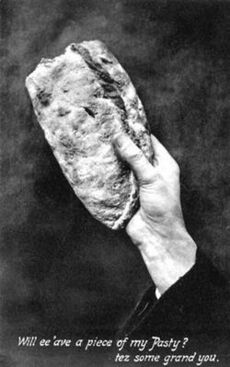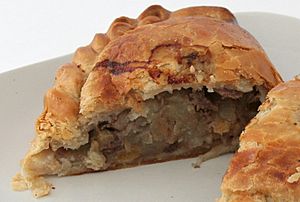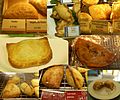Pasty facts for kids
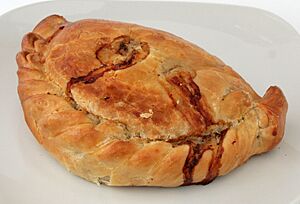
A Cornish pasty
|
|
| Course | Main, snack |
|---|---|
| Place of origin | United Kingdom |
| Region or state | England (Cornwall, Devon) |
| Main ingredients | A pastry case traditionally filled with beef skirt, potato, swede and onion |
| Variations | N/A |
A pasty is a tasty baked pastry from Britain. It's especially famous in Cornwall, a county in South West England. But you can find pasties all over the British Isles and even in other parts of the world!
To make a pasty, you put uncooked filling (usually meat and vegetables) onto a flat circle of shortcrust pastry. Then, you fold the pastry over, crimp the edges to seal it, and bake it.
The most famous kind is the traditional Cornish pasty. Since 2011, it has a special status in Europe called Protected Geographical Indication (PGI). This means only pasties made in Cornwall, following a specific recipe, can be called "Cornish pasties." They are filled with beef, sliced potato, swede (also called yellow turnip or rutabaga), and onion. They are seasoned with salt and pepper and then baked.
Today, the pasty is a huge part of Cornwall's identity. It's a traditional dish that makes up about 6% of Cornwall's food economy. You can find pasties with many different fillings, and some shops sell only pasties! The pasty is now popular worldwide because Cornish miners and sailors traveled to many countries, taking their favorite food with them.
Contents
History of the Pasty
Even though pasties are strongly linked to Cornwall today, their exact origins are a bit of a mystery. The word "pasty" comes from an old French word for a pie. These pies were often filled with meat like venison or other ingredients, and baked without a dish.
Pasties have been mentioned in cookbooks for a long time. For example, a French cookbook from around 1300 has several pasty recipes. In 1393, another French book described recipes for pasties with venison, veal, beef, or mutton.
Kings and queens even ate pasties! In 1208, King John of England made the town of Great Yarmouth send him 100 herrings baked in 24 pasties every year. A baker even wrote a letter to Henry VIII's wife, Jane Seymour, about a pasty.
Later, in the 1600s and 1700s, pasties became popular with working people in Cornwall and west Devon. Tin miners loved them because they were a complete meal that was easy to carry. The thick pastry kept the food warm for hours. If it got cold, miners could even warm it up on a shovel over a candle!
Some people say miners held the thick, crimped edge of the pasty and threw it away. This was to avoid touching the food with dirty hands, which might have had traces of arsenic from the mines. However, old photos show pasties were often wrapped in paper or cloth and eaten from end to end. Another idea is that miners put their initials on one end. This way, if they didn't finish it, they could easily find their own pasty later.
The Famous Cornish Pasty
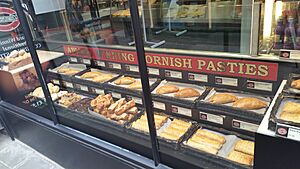
The pasty is like the national dish of Cornwall. People have been talking about "Cornish pasties" since at least the 1860s. An old newspaper from New Zealand in 1843 described how Cornish villagers made small pasties for workers to take to the fields. These pasties could last all week!
In 2011, after a nine-year effort by the Cornish Pasty Association, the name "Cornish pasty" got its special Protected Geographical Indication (PGI) status. This means a true Cornish pasty must:
- Be shaped like a "D".
- Have its edges crimped (sealed) on one side, not on the top.
- Be filled with beef, swede (turnip in Cornwall), potato, and onion.
- Have a light seasoning of salt and pepper, keeping a chunky texture.
- Have golden pastry that holds its shape when cooked.
- Be prepared in Cornwall. The ingredients don't have to be from Cornwall, but many local suppliers are used.
Some pasty makers outside Cornwall were not happy about this rule. But the special status helps protect the traditional Cornish pasty.
In 2008, members of the Cornish Pasty Association made about 87 million pasties! This brought in £60 million (about $75 million USD) in sales. This shows how important pasties are to Cornwall's economy. Many people visit Cornwall just to try the famous pasty.
What's Inside a Pasty?
The official recipe for a Cornish pasty includes diced or minced beef, onion, potato, and swede. These are cut into rough chunks and seasoned with salt and pepper. The beef usually comes from the skirt steak cut. Even though swede is sometimes called turnip in Cornwall, the recipe means the actual swede vegetable.
Some people don't like it when carrots are added to a traditional Cornish pasty, even though you sometimes see them in recipes.
The type of pastry isn't strictly defined, but it should be golden and strong enough not to crack. Most modern pasties use a shortcrust pastry. There's a funny saying that a good pasty's pastry should be strong enough to survive being dropped down a mine shaft!
Different Kinds of Pasties
Even though the official Cornish pasty has specific ingredients, people have always made pasties with whatever food was available. The very first pasty recipes even used venison, not beef! "Pasty" is really just a name for the shape, and it can hold all sorts of fillings.
You can find pasties with Stilton cheese, vegetarian fillings, or even chicken tikka. Shops in Cornwall and Devon often sell pork and apple pasties. There are also sweet pasties with fillings like apple and fig, or chocolate and banana!
Miners in the 1800s sometimes ate a pasty that was half savory and half sweet. This was like a two-course meal in one! Today, these aren't sold much in Cornwall, but you might find them in some supermarkets. Other old fillings included pork, bacon, egg, rabbit, chicken, and even mackerel. Sweet fillings included dates, apples, jam, and sweetened rice. This led to a funny old joke: "the Devil hisself was afeared to cross over into Cornwall for fear that ee'd end up in a pasty."
When times were tough and meat was expensive, people made a "tiddy oggy." "Tiddy" means potato, so it was a pasty with extra potato instead of steak. Another meatless recipe is "herby pie," made with parsley, wild green herbs, chives, and a spoonful of clotted cream.
Pasty Shapes
The PGI rules say a Cornish pasty must be a "D" shape, with the crimping (the sealed edge) along the curved side. However, people in Devon and Cornwall have always crimped pasties in different ways. Some prefer the side crimp, while others think a top crimp is more traditional.
Some say the difference between a Devon and a Cornish pasty is that a Devon pasty has a top crimp and is oval, while a Cornish pasty is semicircular and side-crimped. But many Cornish bakers have made top-crimped pasties for generations. Now, they can't legally call them "Cornish." A famous chef, Paul Hollywood, once said a traditional Cornish pasty should have about 20 crimps!
Pasties Around the World
In the 1800s, as tin mining slowed down in Devon and Cornwall, many miners and their families moved to other countries. They were often called "Cousin Jacks" and "Cousin Jennies." They took their mining skills and their love for pasties with them! Because of this, you can find pasties in many parts of the world:
- Australia: Many parts of Australia, especially the Yorke Peninsula, have strong Cornish roots. They even have a big Cornish festival there every year! Pasties made in Australia can still be called "Cornish Pasties" due to a special rule.
- United States:
* California: You can find pasties in old Gold Rush towns like Grass Valley. * Michigan: The pasty is a big cultural symbol in the Upper Peninsula of Michigan. Pasty shops are a popular tourist stop. Many different groups of immigrants, like Finnish immigrants, adopted the pasty. * Wisconsin: Many early miners in Mineral Point, Wisconsin, came from Cornwall in the 1830s. Pasties are still popular there and in larger cities like Madison. * Montana: In Butte, Montana, Cornish and Welsh miners brought pasties to the copper mines. Miners called the pasty a "letter from 'ome" (home). * Pennsylvania: In the coal mining areas of Northeastern Pennsylvania, miners from the 1800s also brought the pasty.
- Mexico: The state of Hidalgo, especially the silver mining cities of Pachuca and Real del Monte, has a strong Cornish influence. Pasties are a local food there, called pastes. There's even a pasty museum in Real del Monte and an annual International Pasty Festival!
Pasties are also popular in South Africa, New Zealand, and Ulster (Northern Ireland). The Jamaican patty is a similar food that developed from pasties, but with different spices and fillings.
Pasty Culture
When I view my Country o'er:
Of goodly things the plenteous store:
The Sea and Fish that swim therein
And underground the Copper and Tin:
Let all the World say what it can
Still I hold by the Cornishman,
And that one most especially
That first found out the Cornish Pastie.
– Robert Morton Nance, 1898
Pasties in Stories
Pasties have been mentioned in books and stories for a very long time! They appear in a 12th-century story called Erec and Enide, which is about characters from Cornwall. They are also in the 14th-century Robin Hood tales and even in two plays by William Shakespeare.
Pasty Superstitions and Rhymes
In the old tin mines, pasties were linked to "knockers." These were spirits that supposedly made knocking sounds. Miners believed the sounds either showed where rich ore was or warned of a tunnel collapsing. To keep the knockers happy, miners would leave a small piece of their pasty in the mine for them to eat.
Sailors and fishermen also threw a piece of crust into the sea. This was to please the spirits of dead sailors. However, fishermen also believed it was bad luck to take a pasty onto a ship!
An old Cornish saying from 1861 joked about how many different things could go into a pasty. It said the devil wouldn't come to Cornwall because he was afraid of ending up as a pasty filling!
There's also a fun schoolyard rhyme from the 1940s:
The word "oggy" in the popular chant "Oggy Oggy Oggy, Oi Oi Oi" might come from the Cornish word "hoggan" or "hogen," which means pasty. Some say that when pasties were ready, the women working at the mines would shout "Oggy Oggy Oggy" down the shafts, and the miners would shout back "Oi Oi Oi!"
Giant Pasties
Since the pasty is Cornwall's "national dish," people sometimes make huge versions of them! A giant pasty is carried through the streets from Polruan to Fowey during regatta week. Also, a huge pasty is paraded around the rugby field for the Cornish Pirates team on St Piran's Day before being passed over the goal posts.
Images for kids
See also
 In Spanish: Pasty para niños
In Spanish: Pasty para niños
- List of pastries
- List of pies, tarts and flans
- List of potato dishes
- Bridie – A similar Scottish dish
- Calzone – An Italian folded pizza
- Empanada – A similar Spanish dish
- Jamaican patty – A spicy Jamaican version
- Kibinai – Similar pasties from Lithuania
- Knish – An Eastern European pastry
- Meat pie (Australia and New Zealand)
- Mexican pastes – Pasties from Mexico
- Samosa – A similar dish from South Asia
- World Pasty Championships – A competition held every year in Cornwall


